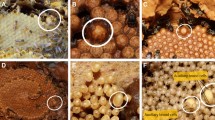Summary
This study used the microsatellite locus B10 to determine the frequency of colonies with multiple patrilines in a previously unexamined group, the North American bumble bees (Bombus). The effective mating frequency (me) was greater than 1 in six of 28 colonies. Five of 11 species tested showed at least one incidence of polyandry: four species from the subgenus Pyrobombus (B. bimaculatus, B. impatiens, B. mixtus, B. ternarius) and one species from the parasitic subgenus Psithyrus (B. citrinus). The B10 locus showed high cross-species amplification success for North American Bombus.
Similar content being viewed by others
Author information
Authors and Affiliations
Corresponding author
Rights and permissions
About this article
Cite this article
Payne, C.M., Laverty, T.M. & Lachance, M.A. The frequency of multiple paternity in bumble bee (Bombus) colonies based on microsatellite DNA at the B10 locus. Insectes Soc. 50, 375–378 (2003). https://doi.org/10.1007/s00040-003-0692-2
Received:
Accepted:
Issue Date:
DOI: https://doi.org/10.1007/s00040-003-0692-2




